Serving 614 students in grades 5-8, William Henry Oliver Middle School ranks in the bottom 50% of all schools in Tennessee for overall test scores (math proficiency is bottom 50%, and reading proficiency is bottom 50%).
The percentage of students achieving proficiency in math is 23% (which is lower than the Tennessee state average of 31%). The percentage of students achieving proficiency in reading/language arts is 26% (which is lower than the Tennessee state average of 37%).
The student:teacher ratio of 18:1 is higher than the Tennessee state level of 15:1.
Minority enrollment is 60% of the student body (majority Black and Hispanic), which is higher than the Tennessee state average of 43% (majority Black and Hispanic).
Quick Stats (2025)
- Grades: 5-8
- Enrollment: 614 students
- Student:Teacher Ratio: 18:1
- Minority Enrollment: 60%
- Overall Testing Rank: Bottom 50% in TN
- Math Proficiency: 23% (Btm 50%)
- Reading Proficiency: 26% (Btm 50%)
- Science Proficiency: 22% (Btm 50%)
- Source: National Center for Education Statistics (NCES), TN Dept. of Education
Top Rankings
William Henry Oliver Middle School ranks among the top 20% of public schools in Tennessee for:
Category
Attribute
Diversity
School Overview
William Henry Oliver Middle School's student population of 614 students has declined by 36% over five school years.
The teacher population of 34 teachers has declined by 34% over five school years.
Grades Offered
Grades 5-8
Total Students
614 students
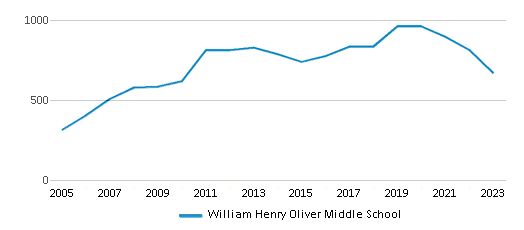
Gender %
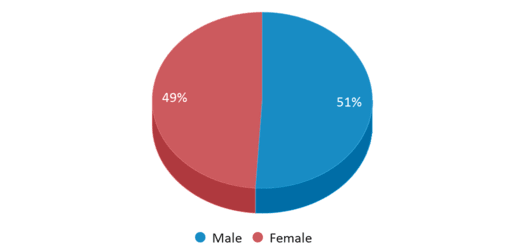
Total Classroom Teachers
34 teachers
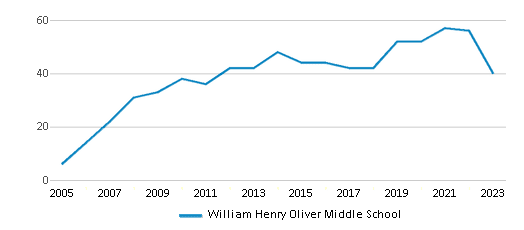
Students by Grade

School Rankings
William Henry Oliver Middle School ranks within the bottom 50% of all 1,761 schools in Tennessee (based off of combined math and reading proficiency testing data).
The diversity score of William Henry Oliver Middle School is 0.73, which is more than the diversity score at state average of 0.61. The school's diversity has stayed relatively flat over five school years.
Overall Testing Rank
#1194 out of 1761 schools
(Bottom 50%)
(Bottom 50%)
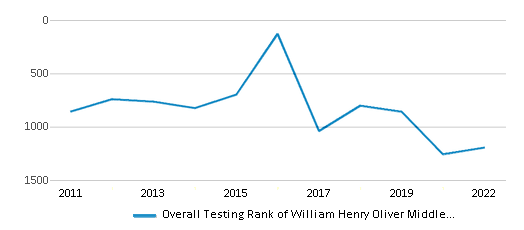
Math Test Scores (% Proficient)
23%
31%
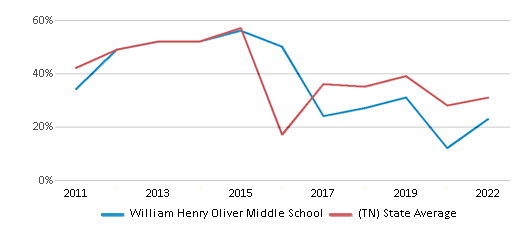
Reading/Language Arts Test Scores (% Proficient)
26%
37%
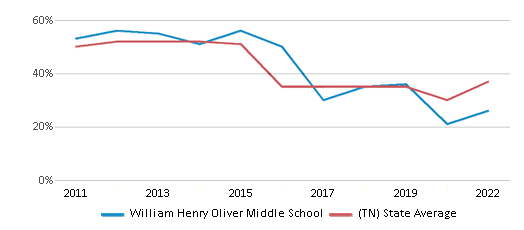
Science Test Scores (% Proficient)
22%
40%
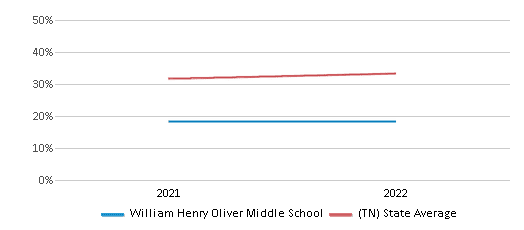
Student : Teacher Ratio
18:1
15:1
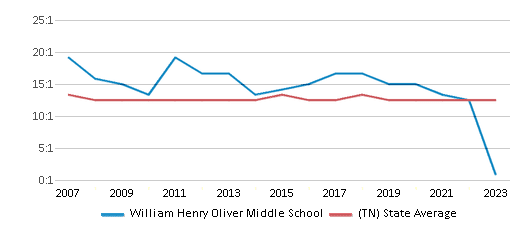
American Indian
n/a
n/a
Asian
9%
2%
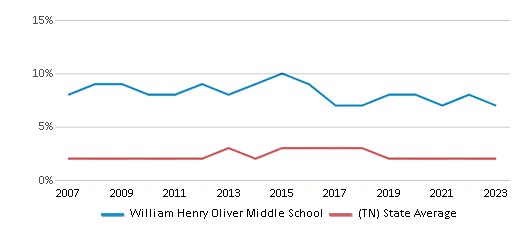
Hispanic
21%
15%
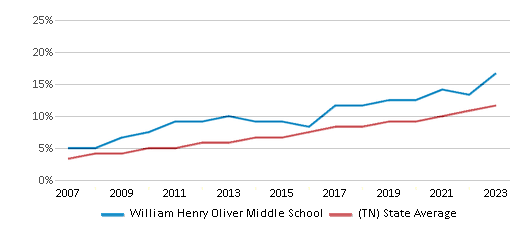
Black
25%
21%
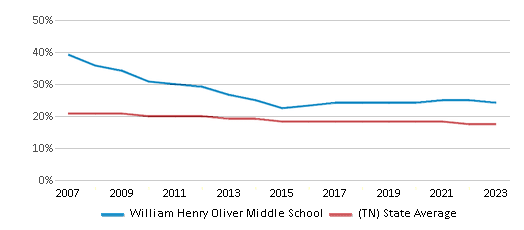
White
40%
57%
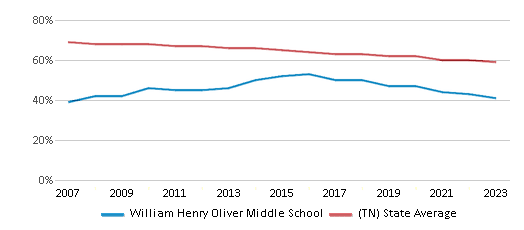
Hawaiian
n/a
n/a
Two or more races
5%
5%
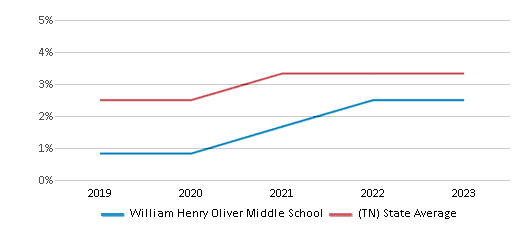
All Ethnic Groups
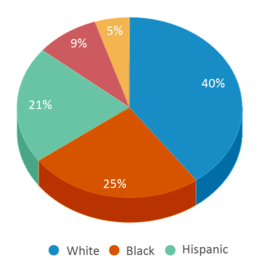
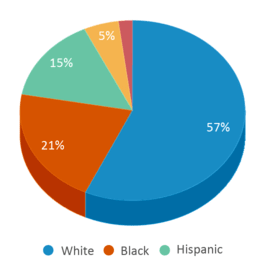
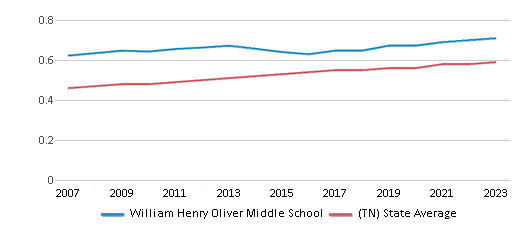
Participates in the National School Lunch Program (NSLP)
Yes
Eligible for Free Lunch
65%
45%
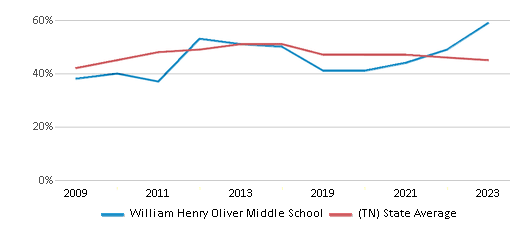
Eligible for Reduced Lunch
6%
6%
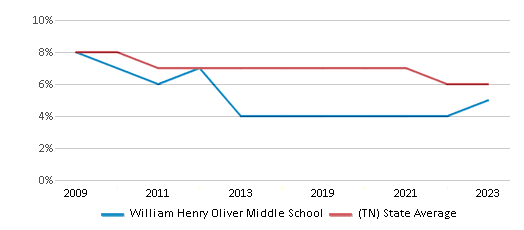
School Statewide Testing
School District Name
Source: National Center for Education Statistics (NCES), TN Dept. of Education
Profile last updated: 02/09/2025
Frequently Asked Questions
What is William Henry Oliver Middle School's ranking?
William Henry Oliver Middle School is ranked #1194 out of 1,761 schools, which ranks it among the bottom 50% of public schools in Tennessee.
What schools are William Henry Oliver Middle School often compared to?
William Henry Oliver Middle Schoolis often viewed alongside schools like John Trotwood Moore Middle School, Isaac Litton Middle School by visitors of our site.
What percent of students have achieved state testing proficiency in math and reading?
23% of students have achieved math proficiency (compared to the 31% TN state average), while 26% of students have achieved reading proficiency (compared to the 37% TN state average).
How many students attend William Henry Oliver Middle School?
614 students attend William Henry Oliver Middle School.
What is the racial composition of the student body?
40% of William Henry Oliver Middle School students are White, 25% of students are Black, 21% of students are Hispanic, 9% of students are Asian, and 5% of students are Two or more races.
What is the student:teacher ratio of William Henry Oliver Middle School?
William Henry Oliver Middle School has a student ration of 18:1, which is higher than the Tennessee state average of 15:1.
What grades does William Henry Oliver Middle School offer ?
William Henry Oliver Middle School offers enrollment in grades 5-8
What school district is William Henry Oliver Middle School part of?
William Henry Oliver Middle School is part of Davidson County School District.
School Reviews
3 11/2/2020
I feel like everyone has different experiences but for me 5th and 7th were my favorite years at this school. It was sad that I wasn't able to have my 8th grade graduation during the 2019- 20 school year but overall mine was an ok experience.
5 2/28/2020
W. H. Oliver Middle School is a diverse and welcoming school that values well-rounded student education. The school combines rigorous academics with outstanding fine arts to create an environment for outstanding student growth and development. The Band Program is nationally recognized and is invited to perform all around the country. The school welcomes students of all levels and helps to grow them into future leaders of our community.
Review William Henry Oliver Middle School. Reviews should be a few sentences in length. Please include any comments on:
- Quality of academic programs, teachers, and facilities
- Availability of music, art, sports and other extracurricular activities
Recent Articles

What Is A Charter School?
Explore the world of charter schools in this comprehensive guide. Learn about their history, how they operate, and the pros and cons of this educational innovation. Discover key facts about charter schools, including admission policies, demographics, and funding, as well as what to look for when considering a charter school for your child.

10 Reasons Why High School Sports Benefit Students
Discover the 10 compelling reasons why high school sports are beneficial for students. This comprehensive article explores how athletics enhance academic performance, foster personal growth, and develop crucial life skills. From improved fitness and time management to leadership development and community representation, learn why participating in high school sports can be a game-changer for students' overall success and well-being.

February 05, 2025
Understanding the U.S. Department of Education: Structure, Impact, and EvolutionWe explore how the Department of Education shapes American education, from its cabinet-level leadership to its impact on millions of students, written for general audiences seeking clarity on this vital institution.







